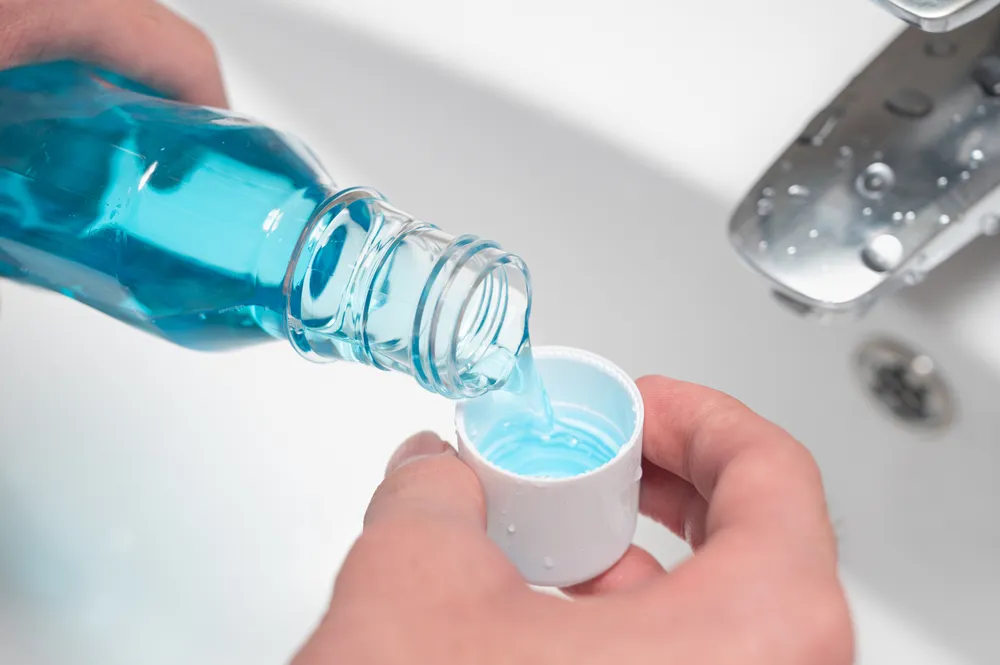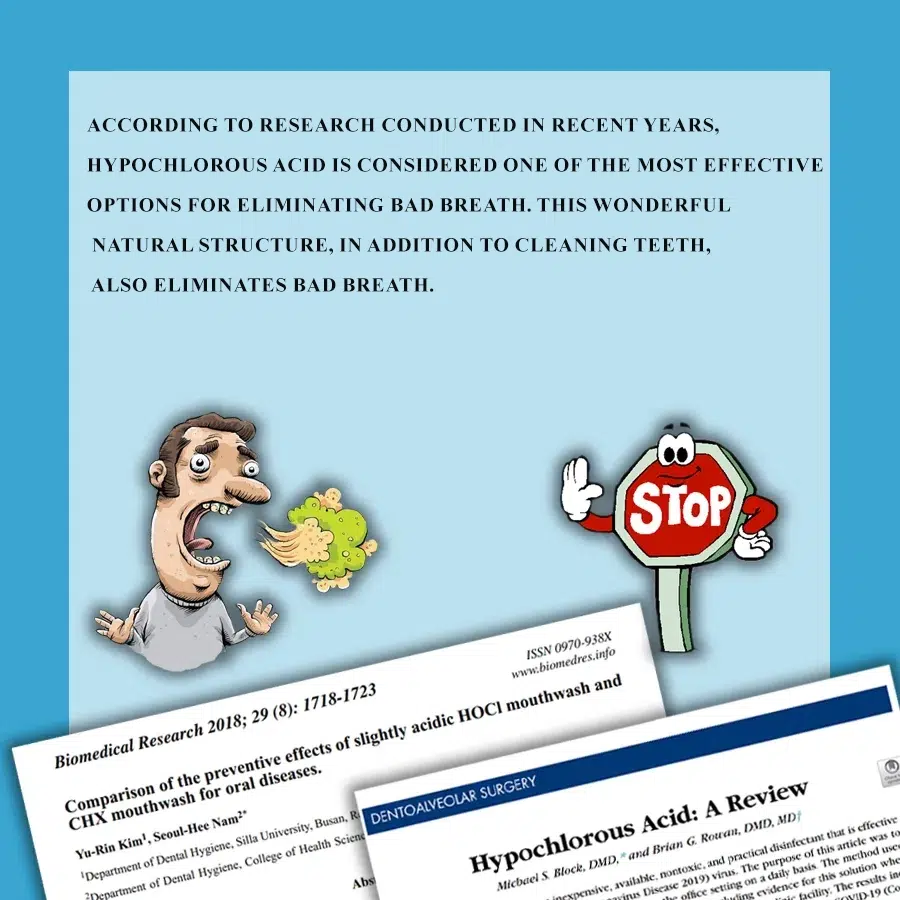
Hypochlorous Acid:
An Innovative Approach
to Oral Health
Home » Hypochlorous acid » Hypochlorous Acid: An Innovative Approach to Oral Health
Introduction
In recent years, personal hygiene—especially oral and dental care—has gained significant attention. This trend is driven by several factors, including increased public awareness, the expansion of educational initiatives focused on oral hygiene, rising dental treatment costs, and a growing variety of health and personal care products. As a result, we have seen substantial improvements in oral health, accompanied by a decrease in severe oral and gum diseases.
Today, it is more important than ever to choose the right products and maintain hygiene practices that support overall well-being. Preventing oral and dental issues requires a commitment to thorough daily care, as neglect can lead to unpleasant conditions like halitosis and, in severe cases, tooth loss. Tooth decay and periodontal diseases are widespread, affecting more than 75% of adults. This discussion will explore these conditions in greater detail:
Dental Caries: Understanding Tooth Decay
Dental caries, commonly referred to as tooth decay, is one of the most prevalent oral health issues today. This condition occurs when bacteria produce acids that erode tooth enamel, particularly in the presence of sugar. Contributing factors include poor oral hygiene practices, a high intake of sugary foods and beverages, and the lack of fluoride toothpaste. If left untreated, tooth decay can advance to impact the nerve of the tooth, causing severe pain and requiring complex treatments such as root canal therapy or tooth extraction. A primary contributor to this process is the bacterium Streptococcus mutans.

Contents
Periodontal Diseases: Understanding Gum Health
Periodontal diseases encompass a range of conditions, including gingivitis, that affect the tissues supporting the teeth. Neglecting gum health can lead to severe complications, including jawbone deterioration and eventual tooth loss. These diseases typically arise from the accumulation of bacterial plaque on the teeth and gums. Research suggests that, in addition to their localized effects, periodontal diseases may be associated with systemic conditions such as diabetes and cardiovascular disease. The microorganisms responsible for periodontal inflammation include anaerobic bacteria, such as filamentous forms and spirochetes.


Preventing and Treating Oral and Dental Diseases
To effectively prevent and manage tooth decay and periodontal diseases, it is crucial to reduce bacterial presence and inhibit the formation of bacterial colonies. Mechanical techniques, such as brushing and mouth rinsing, play a fundamental role in controlling plaque; however, improper execution of these methods can cause significant harm to oral tissues. Additionally, reaching certain hard-to-access areas in the mouth may make these techniques insufficient on their own.
Chemical methods also serve as an effective approach to managing plaque. Mouthwashes have grown in popularity due to their convenience, over-the-counter availability, and portability. Ingredients such as fluoride and xylitol in these mouthwashes are instrumental in preventing tooth decay. Fluoride strengthens tooth enamel, reducing the risk of cavities by making it more resistant to acid attacks. On the other hand, xylitol—a natural sweetener—plays a vital role in oral health by reducing the presence of cavity-causing bacteria and inhibiting their growth.
Mouthwashes are particularly recommended for individuals who may find it challenging to maintain good oral hygiene due to factors like orthodontic appliances, physical disabilities, limited mobility, or advanced age. Clinical research indicates that mouthwashes are effective in removing dental plaque and preventing its formation. Furthermore, studies suggest that using mouthwash not only enhances the outcomes of periodontal treatments but also contributes positively to maintenance after such treatments.
Additionally, mouthwashes can provide relief for those suffering from dry mouth (xerostomia), a condition often caused by medications, health issues, or aging, which can lead to serious oral and dental problems. Regular use of moisturizing mouthwashes can alleviate this condition and help prevent further damage to the oral cavity.

Available Solutions: Advantages and Limitations
While mouthwash can be a beneficial addition to oral hygiene and dental care, it is not essential for daily use and has some drawbacks. Common concerns associated with mouthwash include its often unappealing taste and the potential for tooth staining.
Alcohol-Containing Mouthwashes
One significant issue with many mouthwashes is the inclusion of alcohol in their formulations. Alcohol is commonly added for its antibacterial properties; however, frequent use of these mouthwashes can lead to dry mouth. This happens because the evaporation of alcohol reduces the natural moisture in the mouth, creating an environment that fosters bacterial growth, which can exacerbate bad breath (halitosis) over time.
Complications of Alcohol in Mouthwashes
In addition to the drying effect, several studies have suggested that regular use of alcohol-based mouthwashes may lead to complications such as dental cavities, damage to pharyngeal tissue, and irritation of the larynx. There are also growing concerns about a potential link between these mouthwashes and an increased risk of oral cancer. Although scientific evidence on this matter remains limited and debated, a recent multivariate analysis found no significant relationship between the use of alcohol-containing mouthwashes and the incidence of oral cancer. Nevertheless, some experts recommend alcohol-free mouthwashes as a safer alternative.

Chlorhexidine (CHX) Mouthwash
Chlorhexidine, commonly known as CHX, is recognized as one of the most effective agents for managing dental plaque. Its high absorbency makes it a popular choice for preventing plaque formation and alleviating gingivitis. As a biguanide compound, CHX binds to hydroxyapatite on tooth surfaces and salivary mucin, allowing for gradual release that enhances its long-lasting effectiveness. Chlorhexidine specifically targets Streptococcus mutans (S. mutans), a primary contributor to dental calculus and plaque, thereby helping to reduce bacterial growth
and plaque accumulation. However, the use of chlorhexidine comes with certain challenges. Its strong taste and odor can be unappealing to some users. Additionally, prolonged use of chlorhexidine may result in side effects, including tooth and denture staining, irritation and dryness of the oral mucosa, and a burning sensation in the mouth. Frequent use may also disrupt the natural balance of oral bacteria, potentially leading to toxicity in severe cases. Moreover, its effectiveness can be diminished when used alongside certain oral medications.
Given the side effects and limitations associated with chlorhexidine, it is essential to explore suitable alternatives that offer high effectiveness with fewer side effects and the potential for extended use. Hypochlorous acid stands out for its broad-spectrum antibacterial properties and does not cause issues such as tooth discoloration or irritation of the oral mucosa.

About Hypochlorous Acid (HOCl)
Hypochlorous acid (HOCl) is a powerful antibacterial solution that is naturally produced by all mammals and does not belong to the antibiotic category. This compound is effective against a wide range of microorganisms and plays a vital role in the immune defense system. When the body faces injury or infection, white blood cells—including neutrophils, eosinophils, mononuclear phagocytes, and B lymphocytes—synthesize hypochlorous acid to combat pathogens.
Mechanism of Action of Hypochlorous Acid
As a natural disinfectant and antimicrobial agent, hypochlorous acid effectively eliminates microorganisms through several mechanisms:
Destruction of Microbial Cell Membranes:
Hypochlorous acid selectively binds to the unsaturated lipid layers of microbial cell membranes, including those of bacteria and viruses. This binding alters the membrane structure, weakening its integrity and ultimately leading to cell lysis and destruction.
Strong Oxidizing Properties:
Hypochlorous acid acts as a potent oxidizing agent. It disrupts the structural integrity of proteins and nucleic acids (DNA and RNA) in bacteria and viruses. Its antimicrobial efficacy is optimized at a pH between 3 and 6, where it rapidly dissociates into +H and -OCl ions that actively target and eliminate proteins and cell membranes.
Antiviral Effects:
Hypochlorous acid has strong antiviral properties. It generates chloramines—compounds composed of nitrogen and chlorine—as well as nitrogen radicals, which damage viral DNA and RNA. This process compromises the genetic integrity of viruses, effectively inactivating them. Both single-stranded and double-stranded DNA viruses are vulnerable to this action, resulting in a reduced ability to replicate and cause infections.
Immune System Activation and Tissue Repair:
In addition to its antimicrobial properties, hypochlorous acid acts as a chemotactic agent, directing immune cells such as neutrophils to the infection site. This not only aids in controlling infections but also enhances the overall immune response. By reducing the microbial load and minimizing inflammation, hypochlorous acid facilitates faster tissue repair.
The effectiveness of hypochlorous acid as a disinfectant is influenced by various factors, including contact time, concentration, and the method of application.
How Hypochlorous Acid Works Against Dental Plaque
Biofilm is a complex and organized community of microorganisms that forms a protective layer, shielding underlying bacteria from environmental challenges and immune responses. This biofilm promotes the clustering and growth of microbes in specific areas, increasing their resilience against various antibiotics and disinfectants. Consequently, biofilms play a critical role in microbial resistance observed in both medical and industrial settings.
Antibiofilm Properties of Hypochlorous Acid (HOCl)
Hypochlorous acid (HOCl) exhibits remarkable antibiofilm properties due to its unique characteristics. It effectively penetrates biofilms and eliminates the microorganisms hidden within this protective structure. One of the significant advantages of HOCl over other disinfectants is its superior penetrating power, allowing it to reach the deeper layers of biofilms where resilient and harmful bacteria are often found.
Safety and Effective Concentration of Hypochlorous Acid
- Regulatory Approvals: In 1999, the United States Food and Drug Administration (FDA) approved hypochlorous acid for washing agricultural and marine products. Subsequently, in 2002, Japan’s Ministry of Health, Labor and Welfare recognized the acidic aqueous solution containing HOCl as a permissible food additive. In November 2007, South Korea’s Ministry of Food and Drug Safety also approved it as a safe disinfectant and food additive. As a result, hypochlorous acid has been widely utilized as an eco-friendly disinfectant across various sectors.
- Safety Profile of HOCl as a Mouthwash: The potential for swallowing hypochlorous acid when used as a mouthwash raises safety concerns. A study involving seventeen rats with unrestricted access to water containing HOCl revealed no unusual findings in oral cavity examinations, histological studies, or enamel roughness evaluations. Importantly, there were no systemic effects associated with HOCl consumption. Furthermore, hypochlorous acid is non-irritating to the mucous membranes of the mouth and does not cause pigmentation or discoloration of teeth or dental restorations. Thus, common issues related to certain other mouthwashes are absent with HOCl.
- Effective Concentrations and Antimicrobial Properties: Laboratory studies indicate that mouthwash formulations containing hypochlorous acid at concentrations between 250 and 500 ppm—or lower—exhibit notable antimicrobial properties. These formulations significantly reduce oral pathogenic bacteria without causing harmful effects. These findings suggest that hypochlorous acid mouthwash is a safe and effective option for enhancing oral and dental health.
Persistence of Hypochlorous Acid
A study by Rossi-Fedele et al. investigated the stability of laboratory-synthesized hypochlorous acid (HOCl). The findings revealed that the stability of HOCl decreases when exposed to various factors such as sunlight, ultraviolet (UV) radiation, air, and elevated temperatures above 25°C. To prolong the shelf life of hypochlorous acid, it is recommended to store the solution in cool, dark environments while minimizing exposure to air; these conditions help prevent rapid decomposition.

Effects of Hypochlorous Acid on Oral and Dental Bacteria
A 2016 study demonstrated that a mildly acidic hypochlorous acid solution achieved 99.99% bactericidal efficacy against all tested strains. This research confirmed that both Gram-positive and Gram-negative bacteria, which differ in cell wall thickness, exhibit similar sensitivity to the free chlorine present in HOCl. This significant sensitivity to free chlorine underscores hypochlorous acid as a powerful disinfectant effective against a wide range of pathogenic bacteria.
The table below presents the results of the rapid and complete eradication of some of the most common bacteria that cause dental diseases:
The Antibacterial effect of hypochlorous acid on different strains of oral bacteria
| Bacterial strain | Classification based on the warm staining method | The percentage of bactericidal performance |
|---|---|---|
| Porphyromonas gingivalis | Negative | 999/99 |
| Provotla Intermedia | Negative | 999/99 |
| Provetella nigerescens | Negative | 999/99 |
| Fusobacterium nucleatum | Negative | 9999/99 |
| Streptococcus mutans | Positive | 9999/99 |
| Streptococcus gordonii | Positive | 99/99 |
| Streptococcus oralis | Positive | 99999/99 |
| Streptococcus salivarius | Positive | 9999/99 |
Antibacterial Properties of Hypochlorous Acid Mouthwash in Periodontal Disease Treatment
A 2023 study investigated the antibacterial properties of hypochlorous acid (HOCl) mouthwash at a concentration of 100 ppm against salivary bacteria, including Staphylococcus aureus (S. aureus), in individuals with periodontal diseases such as gingivitis and periodontitis.
Study Design and Groups
Participants in the study were divided into two groups:
- Mouthwash Only Group: This group used mouthwash containing hypochlorous acid exclusively.
- Mouthwash with Dental Floss Group: Participants in this group used mouthwash along with dental floss.
To assess the impact of these treatments, a control group of healthy individuals was also included. Saliva samples were collected from all participants before and after using the mouthwash and dental floss.
Results
The results revealed significant changes in the total salivary bacterial count:
- Participants who used the mouthwash alone experienced a 4% reduction in bacterial count.
- Those who used the mouthwash in conjunction with dental floss saw an even greater decrease of 4% in bacterial count.
This study indicates that a mouthwash containing 100 ppm of hypochlorous acid is effective in significantly reducing overall salivary bacterial counts, particularly Staphylococcus aureus, in individuals suffering from periodontal diseases. The researchers conclude that HOCl mouthwash can be an effective strategy for managing the total salivary bacterial load, especially for those with periodontal problems. Additionally, they recommend incorporating dental floss into the oral hygiene routine to enhance the effectiveness of HOCl mouthwash.

Comparing the Effectiveness of Hypochlorous Acid Mouthwash to Chlorhexidine
A 2015 study investigated the effects of hypochlorous acid (HOCl) and chlorhexidine on the survival rates of various bacteria, including Streptococcus mutans, Actinomyces israelii, Porphyromonas gingivalis, Aggregatibacter actinomycetemcomitans, Eikenella corrodens, Campylobacter rectus, Klebsiella oxytoca, Klebsiella pneumoniae, and Enterobacter cloacae.
Key Findings:
- Chlorhexidine was found to be more effective in reducing the viability of S. mutans, A. israelii, E. corrodens, and E. cloacae.
- Hypochlorous Acid demonstrated greater effectiveness against P. gingivalis, A. actinomycetemcomitans, C. rectus, and K. oxytoca.
- Both hypochlorous acid and chlorhexidine exhibited similar effects on K. pneumoniae.
These findings suggest that hypochlorous acid is generally more effective at eliminating bacteria associated with periodontal diseases, highlighting its potential as a valuable tool for preventing plaque accumulation and managing periodontal conditions.
Further Research in 2018
In 2018, a separate study conducted in South Korea evaluated the effects of three different mouthwash types: a chlorhexidine mouthwash at a concentration of 0.005%, a mildly acidic hypochlorous acid solution, and saline solution. Five participants rinsed with 15 ml of each mouthwash for one minute, followed by a one-minute salivation period to remove any residual solution. The evaluation included assessments of halitosis, the O’Leary dental plaque index, dental caries activity, bacterial species, and bacterial motility.
The study revealed that chlorhexidine had a relative effect compared to the saline solution group. However, participants using the hypochlorous acid mouthwash exhibited significant positive outcomes. Notably, hypochlorous acid proved to be more effective in managing halitosis, reducing dental plaque, and controlling oral bacteria.


Conclusion:
The Importance of Hypochlorous Acid in Oral Health Care
Oral and dental health issues pose significant challenges in today’s society, with common conditions such as tooth decay, gum diseases like periodontitis, halitosis (bad breath), and xerostomia (dry mouth). Given the high costs associated with dental care, the need for effective preventive measures has become increasingly crucial.
Maintaining oral hygiene begins with regular brushing, which is the first line of defense against dental problems. However, brushing alone cannot thoroughly clean all areas of the mouth, particularly the gaps between teeth. Therefore, it is essential to incorporate supplementary methods such as dental floss and mouthwash. Each of these methods has its own advantages and disadvantages, and combining them can enhance overall oral health while preventing various dental issues.
Many standard mouthwashes contain low concentrations of alcohol, which can lead to unwanted side effects like dry mouth and potential harm to the larynx and pharynx. A dry mouth can significantly contribute to tooth decay and halitosis. Chlorhexidine is another commonly used mouthwash in dentistry, recognized for its powerful antimicrobial properties. However, extended use of chlorhexidine can result in side effects such as tooth and denture discoloration, skin irritation, damage to oral tissues, and inflammation of the oral mucosa.
Given these concerns, alternatives that exhibit strong antimicrobial properties while minimizing adverse effects are highly sought after. Hypochlorous acid is one such promising alternative. It is safe and non-toxic, yet it possesses effective germicidal capabilities, helps prevent tooth decay, and shows significant anti-plaque effects. Research indicates that hypochlorous acid can match or even exceed the effectiveness of chlorhexidine in reducing oral bacteria, dental decay, and plaque accumulation.
In light of these findings, researchers recommend hypochlorous acid as an effective mouthwash for managing periodontal diseases. By incorporating hypochlorous acid into oral care routines, individuals can enjoy a safer and more effective method for maintaining optimal oral health.

